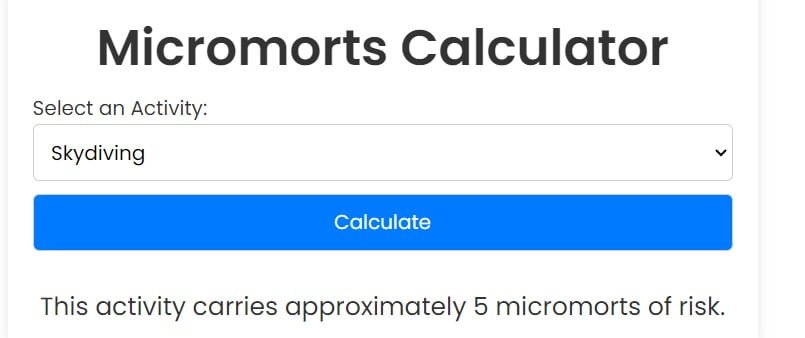Introduction
In a mass of riskful events, I can say with confidence, that risk analysis is a matter of concern. The level of risk is present every time we cross the road, or even pursue some of the most extreme forms of sports. In the end, what is the outcome of knowing or predicting these risks accurately? This is the situation where the micromort and micromort calculator are active.
Table of Contents
What is a Micromort?
The micromort is a measure that involves the calculation of a one-in-a-million risk of death. While this approach was introduced by Ronald A. Howard, he is a professor at Stanford University, it comes with a set of protocols that can be used to identify possible risks in various activities or events. Likewise, a car driver who enjoys a 250-mile-long trip would be estimated at almost one micromort chance of dying; also, an experienced skydiver with just one jump has an equal chance of dying.
How Does a Micromort Calculator Work?
A micromort calculator is designed to break down the numerous risk factors involved in any situation to come up with a lethality probability estimate. These factors may include:
- Activity Type: Various undertakings involve different points of danger. For example, you may list swimming in the pool as low risk while rock climbing as high risk.
- Demographics: Age, sex, and other demographic characteristics have a role to play in the degree of exposure or in the level of risk. For example, the younger generation, as a rule, represents lower risks than people who are in active adulthood.
- Geographical Location: The danger of certain events depends on the place where you live. As an example, the sorts of hazards involved in hiking in the high mountains may be very different from those existing in flat terrain.
- Specific Circumstances: For instance, if the equipment is outdated, the likelihood of risk increases, and also the weather is very bad the health condition of the workers is an additional factor that plays a role in risk.
The calculator is empowering in the sense that users impute these variables into the micromort calculator and get an approximation of the prospect of death percentage connected with a particular activity.
Why Use a Micromort Calculator?
Using a micromort calculator can be beneficial for several reasons:
- Informed Decision-Making: Armed with information about the risks involved, individuals can make better decisions about whether to engage in certain activities or take precautions to mitigate risk.
- Comparative Analysis: Micromorts provide a standardized way to compare the risks of different activities. This can help prioritize safety measures or allocate resources more effectively.
- Risk Perception: Understanding micromorts can help individuals develop a more accurate perception of risk, avoiding overestimation or underestimation of danger.
Conclusion
Having such a micromort calculator in an unpredictable world empowers us to tackle risk in a way we always wanted to. The certainty of death elicited by the calculators of appCalculates is the measure of the cost versus safety expedient for your decisions concerning safety. Locate it or thinking about planning recreation means you have to understand what the micromorts are in order to have safer and meaningful living.
FAQs
1. How do you calculate a micromort?
A micromort is calculated by assessing the probability of death associated with a specific activity or event. It represents a one-in-a-million chance of death. To calculate it, various factors such as the type of activity, demographic information, geographical location, and specific circumstances are taken into account.
2. How many micromorts is driving a car?
Driving a car typically results in around one micromort per 250 miles traveled. However, the exact number of micromorts can vary based on factors such as driving conditions, location, and individual behavior.
3. What is an example of a micromort?
An example of a micromort is skydiving for a highly experienced skydiver, which generally carries a risk of around 7 micromorts per jump. This means that for every million skydives by experienced individuals, approximately 7 deaths would occur.
4. What is the probability of a micromort?
The probability of a micromort represents the chance of death associated with a specific activity or event, expressed as one in a million.
5. How to calculate death rate per 100,000?
To calculate the death rate per 100,000 individuals, divide the number of deaths by the population at risk and then multiply by 100,000. The formula is:
Death rate= (Number of death÷ P0pulation at risk) ×100,000Death Rate
This formula expresses the number of deaths per 100 individuals in the population over a specified period. It is commonly used in epidemiology and public health to assess the impact of diseases or other causes of death on a population.


